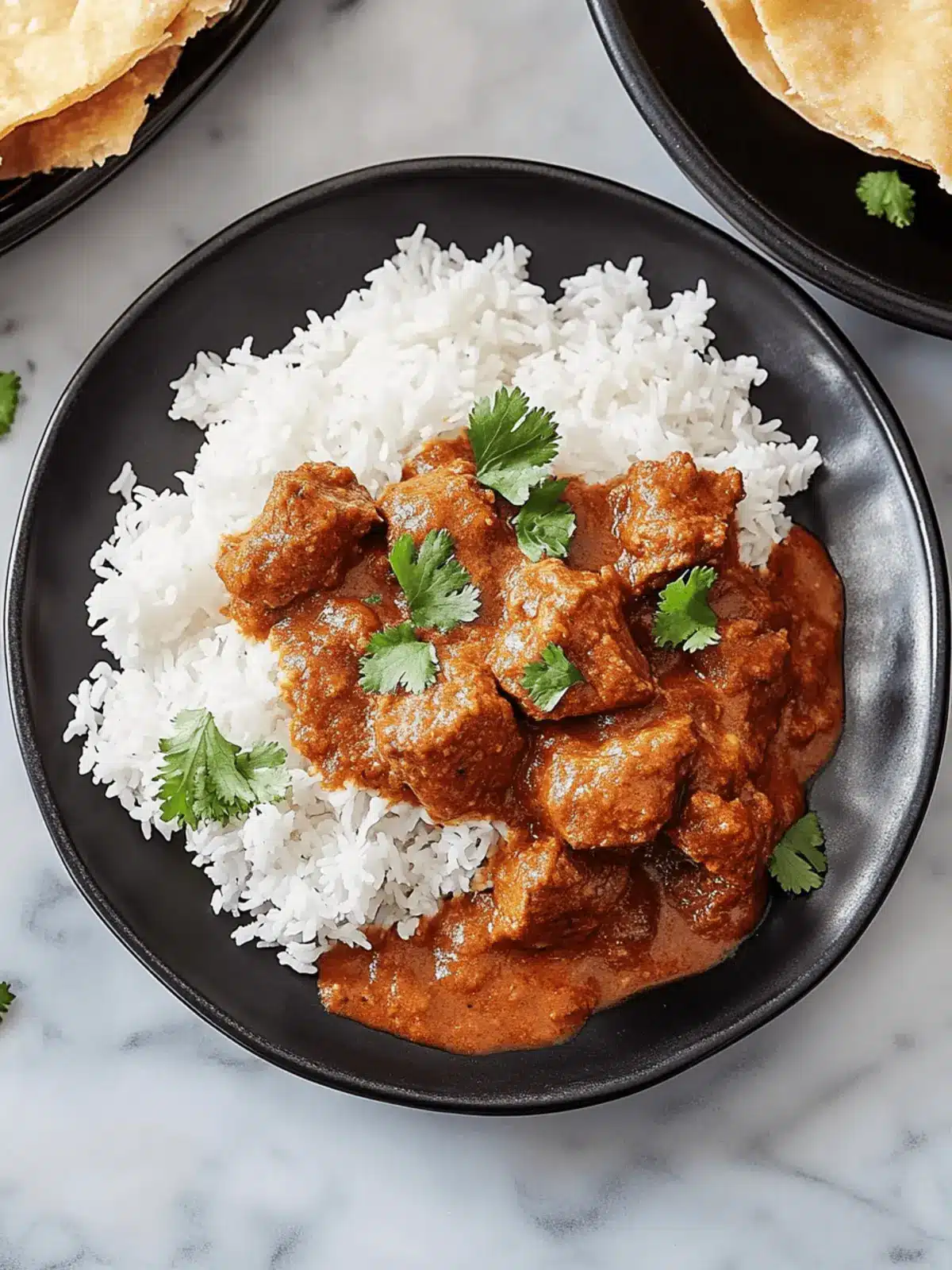After a long day, nothing satisfies quite like the warmth of a hearty meal simmering on the stove. This Classic North Indian Lamb Curry transforms tender lamb into a comforting dish, enveloped in a rich tapestry of spices that evoke the vibrant spirit of Indian cuisine. I discovered this recipe while flipping through a cherished cookbook, and it quickly became a staple in my home.
Imagine the aromatic blend of garlic and ginger filling your kitchen, as succulent pieces of lamb cook away, each bite bursting with flavor. What’s delightful about this curry is its balance of strong spices and easy preparation, making it an impressively simple dish that delights family and guests alike. Whether you’re gathering loved ones around the table or just seeking solace in a comforting bowl of goodness, this lamb curry promises to deliver both flavor and warmth. So, roll up your sleeves, and let’s dive into this culinary journey that beckons with every inviting spoonful!
Why is this Lamb Curry a must-try?
Flavorful, Complex Spices: The array of spices creates a symphony of taste that will enchant your palate.
Hearty and Satisfying: Each spoonful is a delightful hug, perfect for cozy nights or family gatherings.
Simple Preparation: You’ll be amazed at how easy it is to whip up this dish, even for beginner cooks!
Versatile Options: Feel free to customize with chicken or serve over a bed of quinoa for a unique touch.
Crowd-Pleaser: This curry is bound to impress your guests, sparking compliments with every bite!
Lamb Curry Ingredients
For the Curry
• Boneless leg of lamb – Choose a quality cut for ultimate tenderness.
• Ground coriander – Provides a warm, aromatic flavor; substitute with ground cumin if needed.
• Ground cumin – Adds earthiness to the dish; if unavailable, double the coriander.
• Smoked paprika – Introduces a subtle smokiness; can be replaced with regular paprika.
• Kosher salt – Enhances flavor balance; use sea salt as an alternative.
• Cayenne – Adds heat to the curry; adjust quantity to taste or omit for milder curry.
• Ground turmeric – Provides a warm color and earthy flavor; curcumin is a suitable alternative.
• Fresh ginger – Necessary for warmth and zest; can substitute with ginger paste.
• Garlic cloves – Imparts depth of flavor; use garlic powder if fresh is unavailable.
• Canola or vegetable oil – Cooking medium; olive oil can be used but may alter flavor slightly.
• Medium red onion – Adds sweetness and body to the sauce; yellow onions can be substituted.
• Canned tomato sauce – Forms the base of the curry; fresh tomatoes can be used but may require water adjustments.
• Water – Necessary for sauce consistency; use broth for added flavor.
• Fresh cilantro – For garnish, adding freshness; mint can be used for a different flavor profile.
For Serving
• Cooked basmati rice – Suggested side for serving; quinoa serves as a gluten-free option.
• Naan – Traditional accompaniment; serve with any flatbread for an alternative.
How to Make Lamb Curry
-
Prepare ingredients: Start by dicing the boneless leg of lamb into bite-sized pieces. Chop the red onion, garlic, and fresh ginger into fine bits, setting them aside for the cooking process.
-
Sauté aromatics: In a large pot, heat canola or vegetable oil over medium heat. Add the chopped onions, garlic, and ginger, cooking until the onions are translucent and fragrant, about 5-7 minutes.
-
Brown the lamb: Increase the heat slightly, then add the lamb cubes to the pot. Brown them on all sides, stirring occasionally, for about 5-8 minutes until they develop a nice color.
-
Add spices and sauce: Stir in the ground coriander, ground cumin, smoked paprika, cayenne, turmeric, and kosher salt. Mix these with the browned lamb, then pour in the canned tomato sauce and a cup of water. Bring the mixture to a bubbling boil.
-
Simmer: Lower the heat, cover the pot, and let the curry simmer gently for about 1 hour. The lamb should become tender, and the flavors will meld beautifully—check occasionally.
-
Adjust seasoning: Once the lamb is tender, taste the curry, and adjust the salt and spices as necessary to your preference.
-
Garnish and serve: Remove from heat, garnish with freshly chopped cilantro, and serve the lamb curry hot, alongside fluffy basmati rice and warm naan.
Optional: Drizzle a little lime juice over the curry for a zesty kick.
Exact quantities are listed in the recipe card below.
Make Ahead Options
These Classic North Indian Lamb Curry preparations are a game changer for busy weeknights! You can chop and marinate the lamb, along with preparing the aromatics (onion, garlic, and ginger), up to 24 hours in advance; simply store them in the refrigerator in an airtight container. The curry itself can be made and cooled, then refrigerated for up to 3 days. When you’re ready to enjoy your lamb curry, just reheat it gently on the stovetop, allowing time for the flavors to meld again. This way, you still enjoy a comforting meal that’s just as delicious as if made fresh. With these make-ahead options, you’ll save invaluable time with every cozy family dinner!
Expert Tips for the Best Lamb Curry
- Fresh Spices: Always use fresh spices for your lamb curry. They enhance flavor significantly compared to old, stale spices.
- Don’t Overcook: Avoid overcooking the lamb; it should be tender but not falling apart. Keep an eye on it during simmering!
- Rest for Flavor: Allow the curry to rest for a few minutes off the heat before serving; this helps enhance the overall flavors.
- Balance Heat: Adjust the cayenne to your taste. Start with a smaller amount if you’re unsure, and increase as desired for your lamb curry.
- Customize Vegetables: Feel free to add vegetables like peas or potatoes to the curry for added nutrition and texture.
What to Serve with Classic North Indian Lamb Curry?
Nothing pairs better with a heartwarming lamb curry than thoughtful sides that enhance its rich flavors.
- Fluffy Basmati Rice: Provides a light, neutral base for the curry, soaking up the flavorful sauce with each bite.
- Soft Naan: This traditional Indian bread is perfect for scooping up the curry, adding a comforting, chewy texture to each mouthful.
- Fresh Cucumber Raita: A cooling yogurt sauce with cucumber that balances the curry’s spice while adding a refreshing contrast.
- Spicy Pickled Onions: These bright pink onions add a tangy crunch, providing a delightful contrast to the rich, tender lamb.
- Roasted Vegetables: Caramelized carrots and bell peppers bring sweetness and a bit of earthiness that beautifully complements the savory notes of the curry.
- Mango Chutney: This sweet and tangy condiment brightens the palate, making it a perfect sweet contrast to the curry’s savory depth.
- Sliced Green Chilies: For a spicy kick, serve fresh green chilies on the side, letting guests adjust the heat to their preference.
- Masala Chai: A warm, spiced tea rounds out the meal, offering a cozy drink that echoes the savory spices of the dish.
Lamb Curry Variations & Substitutions
Feel free to tweak this recipe to match your taste preferences and dietary needs.
- Chicken Substitute: Use boneless chicken thighs for a lighter version, adjusting the cooking time.
- Vegetarian Twist: Swap lamb for chickpeas or lentils, simmering until fully cooked for a hearty vegetarian dish.
- Extra Veggies: Add diced potatoes or spinach for added nutrition and a pop of color, infusing each bite with wholesome goodness.
- Creamy Texture: Stir in a dollop of yogurt or coconut milk at the end for a deliciously creamy curry that will enrich the flavors.
- Smoky Flavor Boost: Incorporate smoked sausage or chorizo for an unexpected twist, bringing additional depth to the dish with every bite.
- Heat Levels: Toss in some green chilies for a spicy kick or adjust cayenne to taste for milder flavors, allowing customization based on your heat preference.
- Fresh Herbs: Experiment with fresh mint or parsley instead of cilantro to refresh the profile, offering a delightful change in flavor.
- Nutritional Boost: Blend in grated carrots or zucchini for a healthy dose of veggies, enhancing the texture and flavor while keeping it vibrant and satisfying.
How to Store and Freeze Lamb Curry
- Fridge: Store leftover lamb curry in an airtight container for up to 3 days. Allow it to cool completely before sealing to prevent moisture buildup.
- Freezer: Freeze the lamb curry for up to 3 months. Use freezer-safe containers or bags, removing excess air before sealing for optimal freshness.
- Reheating: Thaw overnight in the fridge before reheating. Gently heat the lamb curry on the stove over low heat, adding a splash of water or broth to maintain its sauciness.
- Tips: For the best flavor, consider freezing in individual portions. This way, you can enjoy a comfort-food serving of lamb curry anytime!
Classic North Indian Lamb Curry Recipe FAQs
What type of lamb is best for this recipe?
For the most tender and flavorful results, choose a boneless leg of lamb. This cut has the right amount of fat to keep the curry juicy and rich. You can also use shoulder chops if they’re on sale, but make sure to trim any excess fat.
How should I store leftover lamb curry?
Store leftover lamb curry in an airtight container in the refrigerator for up to 3 days. Allow it to cool completely before sealing to prevent moisture buildup, which can lead to spoilage. You can enjoy the rich flavors of the curry even after a day or two!
Can I freeze lamb curry, and how do I do it?
Absolutely! You can freeze lamb curry for up to 3 months. To do this, let the curry cool completely, then transfer it into freezer-safe containers or bags, squeezing out as much air as possible before sealing. Label it with the date so you can keep track. When you’re ready to eat, thaw it overnight in the fridge and reheat gently on the stove.
What if my lamb curry is too spicy?
If your lamb curry has turned out spicier than you intended, don’t worry! You can mellow the heat by adding a bit of sugar or coconut milk to balance the flavors. Alternatively, incorporating dairy products like yogurt at the end can help reduce the spiciness while adding creaminess to the dish.
Are there any dietary concerns I should be aware of?
Yes! If you have dietary restrictions, consider the following: the recipe includes lamb, a red meat, which may not be suitable for all diets. For allergies, ensure no one is sensitive to spices like cumin or paprika. If serving to pets, keep human food separate to avoid harmful ingredients like garlic.
What ingredients can I substitute for a different flavor?
You can easily customize your lamb curry by substituting chicken or beef for the lamb, which will provide distinct flavor profiles. If you’re looking to add more nutrition, toss in vegetables like peas, carrots, or even spinach. For creaminess, try adding a bit of yogurt or coconut milk towards the end of cooking.

Savory Lamb Curry: Your Ultimate Comfort Food Adventure
Ingredients
Equipment
Method
- Prepare ingredients: Start by dicing the boneless leg of lamb into bite-sized pieces. Chop the red onion, garlic, and fresh ginger into fine bits, setting them aside for the cooking process.
- Sauté aromatics: In a large pot, heat canola or vegetable oil over medium heat. Add the chopped onions, garlic, and ginger, cooking until the onions are translucent and fragrant, about 5-7 minutes.
- Brown the lamb: Increase the heat slightly, then add the lamb cubes to the pot. Brown them on all sides, stirring occasionally, for about 5-8 minutes until they develop a nice color.
- Add spices and sauce: Stir in the ground coriander, ground cumin, smoked paprika, cayenne, turmeric, and kosher salt. Mix these with the browned lamb, then pour in the canned tomato sauce and a cup of water. Bring the mixture to a bubbling boil.
- Simmer: Lower the heat, cover the pot, and let the curry simmer gently for about 1 hour. The lamb should become tender, and the flavors will meld beautifully—check occasionally.
- Adjust seasoning: Once the lamb is tender, taste the curry, and adjust the salt and spices as necessary to your preference.
- Garnish and serve: Remove from heat, garnish with freshly chopped cilantro, and serve the lamb curry hot, alongside fluffy basmati rice and warm naan.








